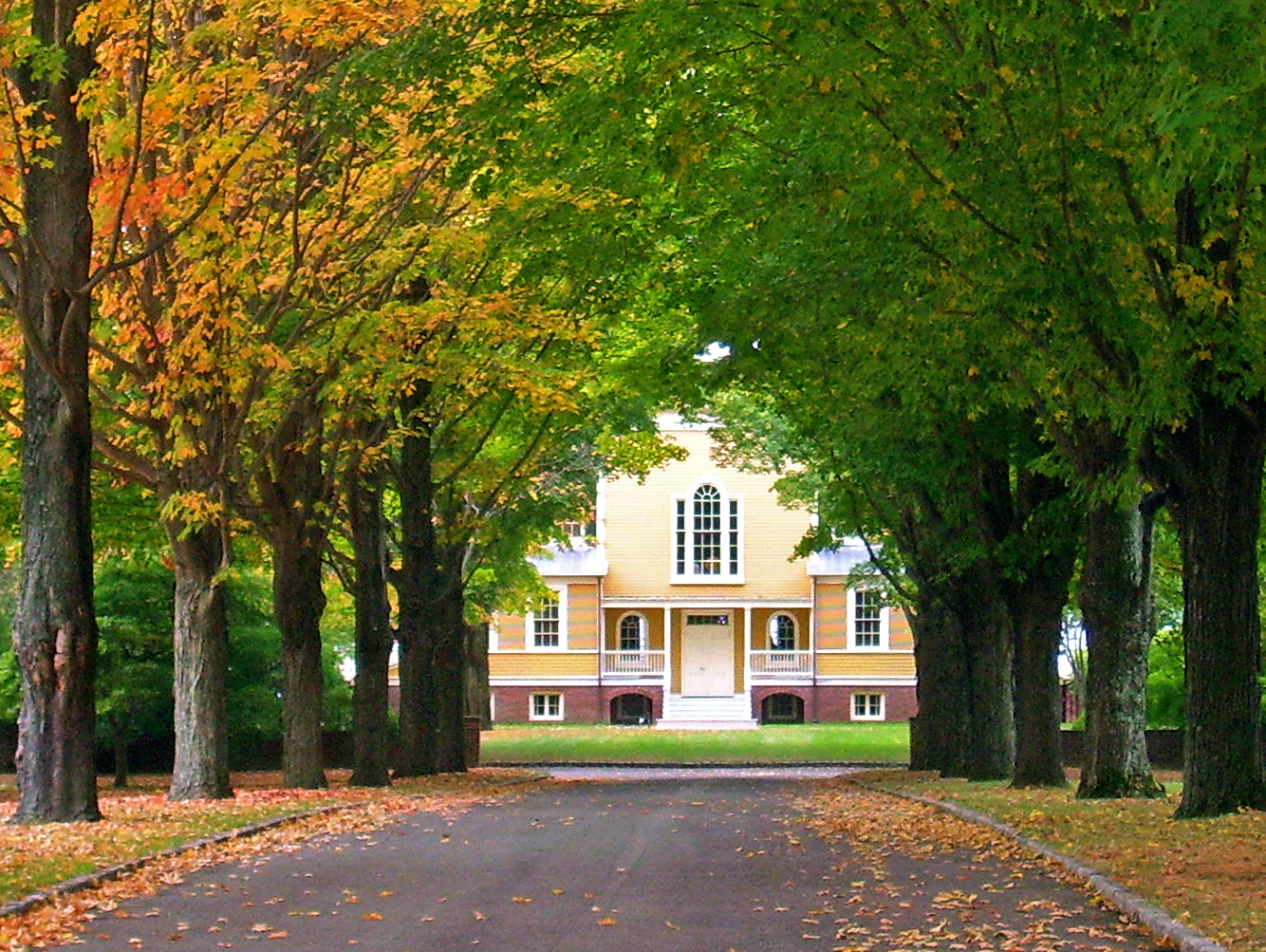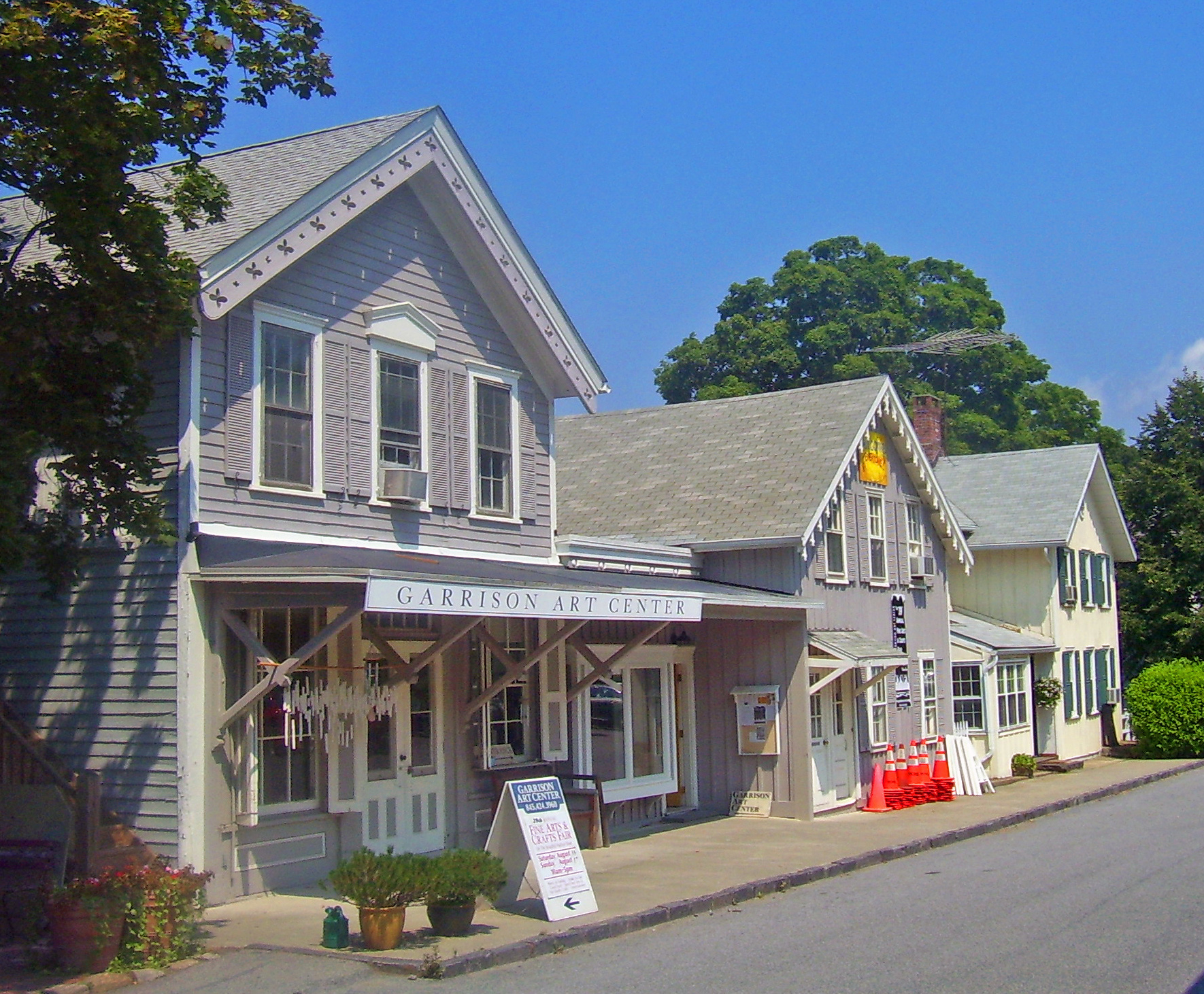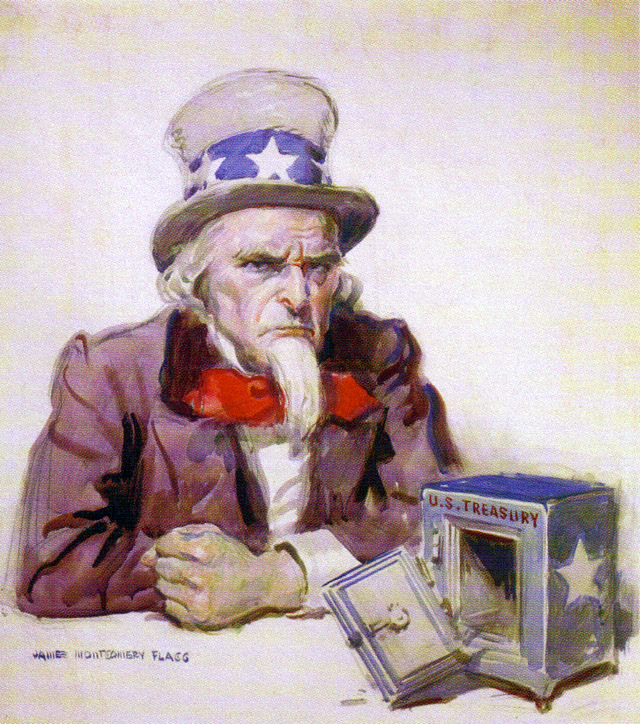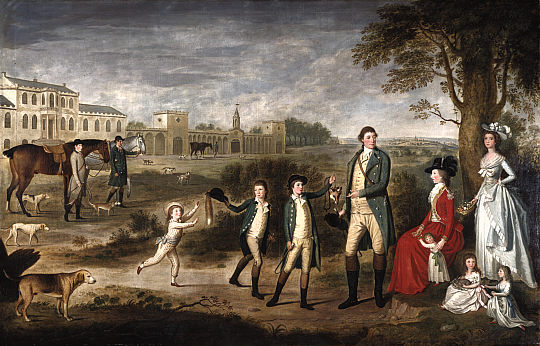|
Boscobel (mansion)
Boscobel is a historic house museum in Garrison, New York, overlooking the Hudson River. The house was built in the early 19th century by States Dyckman. It is considered an significant example of the Federal style of American architecture, augmented by Dyckman's extensive collection of period decorations and furniture. It was originally located in the Westchester County hamlet of Montrose. Restoration efforts in the mid-20th century moved it upriver to where it currently stands, on New York State Route 9D a mile south of the village of Cold Spring in Putnam County. House Boscobel's distinguishing feature is the unusual delicacy conveyed by the front facade and its ornamentation. Unique among Federal style buildings, carved wooden swags in the shape of drapery, complete with tassels and bowknots, grace the top of the second-story balcony. Nearly one-third of the face is glass, with flanking lights integrated into contemporary windows used in the restoration to enhance the e ... [...More Info...] [...Related Items...] OR: [Wikipedia] [Google] [Baidu] |
Garrison, New York
Garrison is a hamlet in Putnam County, New York, United States. It is part of the town of Philipstown, on the east side of the Hudson River, across from the United States Military Academy at West Point. The Garrison Metro-North Railroad station serves the town. Garrison (a.k.a. Garrison's Landing) was named after 2nd Lieutenant Isaac Garrison, who held a property lot on the Hudson River across from West Point and conducted a ferry service across the Hudson River between the two hamlets. Isaac and his son Beverly Garrison fought in the Battle of Fort Montgomery in 1777, were captured by the British and later set free. The Garrison train wreck took place near Garrison on the Great Hudson River Railway on October 24, 1897, killing 20 people. For the 1969 film '' Hello, Dolly!'' starring Barbra Streisand, Garrison was the filming location for the Yonkers scenes. The Saint Basil Academy in the town served as the finish line of ''The Amazing Race 10'' in 2006. Organization ... [...More Info...] [...Related Items...] OR: [Wikipedia] [Google] [Baidu] |
Hudson River School
The Hudson River School was a mid-19th century American art movement embodied by a group of landscape painters whose aesthetic vision was influenced by Romanticism. The paintings typically depict the Hudson River Valley and the surrounding area, including the Catskill, Adirondack, and White Mountains. Works by second generation artists expanded to include other locales in New England, the Maritimes, the American West, and South America. Overview The term Hudson River School is thought to have been coined by the ''New York Tribune'' art critic Clarence Cook or by landscape painter Homer Dodge Martin. It was initially used disparagingly, as the style had gone out of favor after the ''plein-air'' Barbizon School had come into vogue among American patrons and collectors. Hudson River School paintings reflect three themes of America in the 19th century: discovery, exploration, and settlement. They also depict the American landscape as a pastoral setting, where human beings and n ... [...More Info...] [...Related Items...] OR: [Wikipedia] [Google] [Baidu] |
Wedgwood
Wedgwood is an English fine china, porcelain and luxury accessories manufacturer that was founded on 1 May 1759 by the potter and entrepreneur Josiah Wedgwood and was first incorporated in 1895 as Josiah Wedgwood and Sons Ltd. It was rapidly successful and was soon one of the largest manufacturers of Staffordshire pottery, "a firm that has done more to spread the knowledge and enhance the reputation of British ceramic art than any other manufacturer", exporting across Europe as far as Russia, and to the Americas. It was especially successful at producing fine earthenware and stoneware that were accepted as equivalent in quality to porcelain (which Wedgwood only made later) but were considerably cheaper. Wedgwood is especially associated with the "dry-bodied" (unglazed) stoneware Jasperware in contrasting colours, and in particular that in "Wedgwood blue" and white, always much the most popular colours, though there are several others. Jasperware has been made continuously ... [...More Info...] [...Related Items...] OR: [Wikipedia] [Google] [Baidu] |
Robert Adam
Robert Adam (3 July 17283 March 1792) was a British neoclassical architect, interior designer and furniture designer. He was the son of William Adam (1689–1748), Scotland's foremost architect of the time, and trained under him. With his older brother John, Robert took on the family business, which included lucrative work for the Board of Ordnance, after William's death. In 1754, he left for Rome, spending nearly five years on the continent studying architecture under Charles-Louis Clérisseau and Giovanni Battista Piranesi. On his return to Britain he established a practice in London, where he was joined by his younger brother James. Here he developed the "Adam Style", and his theory of "movement" in architecture, based on his studies of antiquity and became one of the most successful and fashionable architects in the country. Adam held the post of Architect of the King's Works from 1761 to 1769. Robert Adam was a leader of the first phase of the classical revival in En ... [...More Info...] [...Related Items...] OR: [Wikipedia] [Google] [Baidu] |
Neoclassicism
Neoclassicism (also spelled Neo-classicism) was a Western cultural movement in the decorative and visual arts, literature, theatre, music, and architecture that drew inspiration from the art and culture of classical antiquity. Neoclassicism was born in Rome largely thanks to the writings of Johann Joachim Winckelmann, at the time of the rediscovery of Pompeii and Herculaneum, but its popularity spread all over Europe as a generation of European art students finished their Grand Tour and returned from Italy to their home countries with newly rediscovered Greco-Roman ideals. The main Neoclassical movement coincided with the 18th-century Age of Enlightenment, and continued into the early 19th century, laterally competing with Romanticism. In architecture, the style continued throughout the 19th, 20th and up to the 21st century. European Neoclassicism in the visual arts began c. 1760 in opposition to the then-dominant Rococo style. Rococo architecture emphasizes grace, ornamentati ... [...More Info...] [...Related Items...] OR: [Wikipedia] [Google] [Baidu] |
American Independence
The American Revolution was an ideological and political revolution that occurred in British America between 1765 and 1791. The Americans in the Thirteen Colonies formed independent states that defeated the British in the American Revolutionary War (1775–1783), gaining independence from the British Crown and establishing the United States of America as the first nation-state founded on Enlightenment principles of liberal democracy. American colonists objected to being taxed by the Parliament of Great Britain, a body in which they had no direct representation. Before the 1760s, Britain's American colonies had enjoyed a high level of autonomy in their internal affairs, which were locally governed by colonial legislatures. During the 1760s, however, the British Parliament passed a number of acts that were intended to bring the American colonies under more direct rule from the British metropole and increasingly intertwine the economies of the colonies with those of Brit ... [...More Info...] [...Related Items...] OR: [Wikipedia] [Google] [Baidu] |
War Profiteering
A war profiteer is any person or organization that derives profit (economics), profit from warfare or by selling weapons and other goods to parties at war. The term typically carries strong negative connotations. General profiteering (business), profiteering, making a profit criticized as excessive or unreasonable, also occurs in peacetime. An example of war profiteers were the shoddy millionaires, "shoddy" millionaires who allegedly sold recycled wool and cardboard shoes to soldiers during the American Civil War. Some have argued that major modern defense conglomerates like Lockheed Martin, Boeing, BAE Systems, General Dynamics, and Raytheon fit the description in the post-9/11 era. This argument is based in the military-industrial complex, political influence of the arms industry, defense industry, for example in 2010 the defense industry spent $144 million on lobbying and donated over $22.6 million to congressional candidates, as well as large profits for defense company shareh ... [...More Info...] [...Related Items...] OR: [Wikipedia] [Google] [Baidu] |
Sir William Erskine, 1st Baronet
Lieutenant-General Sir William Erskine, 1st Baronet (1728 – 19 March 1795) was a British Army commander and the 1st Baronet of the Erskine baronets, Erskine of Torrie creation. Background Erskine was the son of Colonel the Honourable William Erskine of Torrie, Deputy Governor of Blackness Castle, Linlithgowshire, and grandson of David Erskine, second Lord Cardross.H. M. Stephens, ‘Erskine, Sir William, second baronet (1770–1813)’, rev. Roger T. Stearn, Oxford Dictionary of National Biography, Oxford University Press, 200accessed 30 May 2008/ref> Erskine first married Magdalen Myrton, daughter of Robert Myrton of Gogar, and then Frances Moray, daughter of James Moray of Abercairny. His eldest son by his second wife, Frances, Sir William Erskine, 2nd Baronet, William, the 2nd baronet was a cavalry officer who committed suicide in Lisbon, Portugal in 1813 after a mental breakdown. He had another son, Sir James Erskine, 3rd Baronet, James, who was an officer in the 133rd ... [...More Info...] [...Related Items...] OR: [Wikipedia] [Google] [Baidu] |
Quartermaster
Quartermaster is a military term, the meaning of which depends on the country and service. In land armies, a quartermaster is generally a relatively senior soldier who supervises stores or barracks and distributes supplies and provisions. In many navies, a quartermaster is an officer with particular responsibility for steering and signals. The seaman is a non-commissioned officer (petty officer) rank; in some others, it is not a rank but a role related to navigation. The term appears to derive from the title of a German royal official, the . This term meant "master of quarters" (where "quarters" refers to lodging or accommodation). Alternatively, it could have been derived from "master of the quarterdeck" where the helmsman and captain controlled the ship. The term's first use in English was as a naval term, which entered English in the 15th century via the equivalent French and Dutch naval titles and , respectively. The term began to refer to army officers in English aroun ... [...More Info...] [...Related Items...] OR: [Wikipedia] [Google] [Baidu] |
British Army
The British Army is the principal land warfare force of the United Kingdom, a part of the British Armed Forces along with the Royal Navy and the Royal Air Force. , the British Army comprises 79,380 regular full-time personnel, 4,090 Gurkhas, and 28,330 volunteer reserve personnel. The modern British Army traces back to 1707, with antecedents in the English Army and Scots Army that were created during the Restoration in 1660. The term ''British Army'' was adopted in 1707 after the Acts of Union between England and Scotland. Members of the British Army swear allegiance to the monarch as their commander-in-chief, but the Bill of Rights of 1689 and Claim of Right Act 1689 require parliamentary consent for the Crown to maintain a peacetime standing army. Therefore, Parliament approves the army by passing an Armed Forces Act at least once every five years. The army is administered by the Ministry of Defence and commanded by the Chief of the General Staff. The Brit ... [...More Info...] [...Related Items...] OR: [Wikipedia] [Google] [Baidu] |
Loyalist (American Revolution)
Loyalists were colonists in the Thirteen Colonies who remained loyal to the British Crown during the American Revolutionary War, often referred to as Tories, Royalists or King's Men at the time. They were opposed by the Patriots, who supported the revolution, and called them "persons inimical to the liberties of America." Prominent Loyalists repeatedly assured the British government that many thousands of them would spring to arms and fight for the crown. The British government acted in expectation of that, especially in the southern campaigns in 1780–81. Britain was able to effectively protect the people only in areas where they had military control, and in return, the number of military Loyalists was significantly lower than what had been expected. Due to the conflicting political views, loyalists were often under suspicion of those in the British military, who did not know whom they could fully trust in such a conflicted situation; they were often looked down upon. Pat ... [...More Info...] [...Related Items...] OR: [Wikipedia] [Google] [Baidu] |
Dutch Colonization Of The Americas
The Netherlands began its colonization of the Americas with the establishment of trading posts and plantations, which preceded the much wider known colonization activities of the Dutch East Indies, Dutch in Asia. While the first Dutch fort in Asia was built in 1600 (in present-day Indonesia), the Essequibo (colony), first forts and settlements along the Essequibo River in Guyana date from the 1590s. Dutch colonisation of the Guianas, Actual colonization, with the Dutch settling in the new lands, was not as common as by other European nations. Many of the Dutch settlements were lost or abandoned by the end of the 17th century, but the Netherlands managed to retain possession of Suriname (Dutch colony), Suriname until it gained independence in 1975. Among its several colonies in the region, only the Dutch Caribbean still remains to be part of the Kingdom of the Netherlands today. Mainland in North America In 1602, the Republic of the Seven United Netherlands chartered a young and ... [...More Info...] [...Related Items...] OR: [Wikipedia] [Google] [Baidu] |




.jpg)





